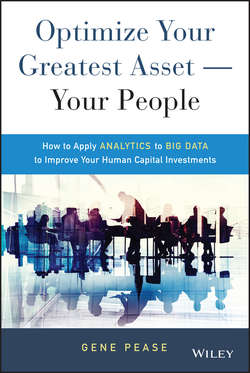Читать книгу Optimize Your Greatest Asset – Your People - Pease Gene - Страница 5
Preface
ОглавлениеIn 2005, I went to the Masie Conference in Florida. It was the first industry conference I had attended since we started Capital Analytics (now Vestrics) the year before. The conference was very interesting with presentations on a wide variety of topics related to learning. However, there were very few presentations at the conference related to measuring and evaluating learning. Those that discussed measurement focused on how to create and deploy better surveys. Among over 100+ scheduled presentations, there was one breakout session on the topic of the return on investment (ROI) of training investments. Approximately 50 people showed up for the discussion, so we put our chairs in a large oval in a banquet room. I was very excited to participate in what I considered the most important topic of the conference. A professor from one of the East Coast business schools kicked off the discussion. The attendees represented middle to senior management learning executives from some of the world's largest and best-known corporations, as well as representatives from many prestigious universities. I was eager to hear from the industry as my team had just started to apply advanced analytics to measure training programs.
For the first 30 minutes or so, one executive after another stated that you can't measure learning investments because people are too complicated and organizations are too complex. Generally, the group believed that measuring ROI was a waste of time and had no value. We had formed Capital Analytics knowing that statistics were being used in many disciplines — drug trials, actuarial work, supply chain optimization, and many others. Even marketing (which had long been thought of as an art form) was beginning to apply statistics to better understand the effectiveness of their investments. What's the old saying? I knew that 50 percent of my marketing budget was wasted; I just didn't know which 50 percent.
The discussion was hard for me to believe. And it went on and on. I couldn't stand it any longer and meekly raised my hand. When called upon, I stated that I strongly disagreed with their opinions. Our scientists (from Duke University, by the way!) were applying statistical work to learning investments. This work was enabling us to see insights into the investments that qualitative methods could not uncover.
You would have thought I was from Mars with the violent reaction to my comments. The next half-hour turned into a free-for-all of 50 against 1 (me). The argument both discouraged and energized me. I was discouraged to learn that the learning profession was so far behind in thinking about how to link investments to business outcomes. It discouraged me enough that I didn't attend another industry conference for the next three years.
However, in spite of this beat down, I knew this work could be done, and it energized me to show the industry that it could be done. So we quietly stuck to the work over the next 10 years and, along with others, helped shepherd advanced analytics into the human capital profession. Look at where we are a decade later. There is significant proof that applying analytics and understanding how investments are working significantly improves business outcomes. We now use predictive analytics to help navigate rapidly changing work environments. Big data allows us to capture both structured and unstructured data and turn it into information that enables us to make better-informed decisions.
I have co-authored two books on how to design and deploy advanced analytics for human capital investments. I was fortunate to have co-authored those books with a very talented group of experts in the field of measurement. The books were based primarily on the work and numerous mistakes we made, as we built on decades of previous work in the industry and added predictive analytics into the mix. These books focused on HOW to get started and do the work. This new book focuses more on WHY we should be doing the work every day.
As significant research shows, Human Resources (HR) is playing catch-up with adopting analytics. Some of us estimate the HR profession is about where marketing was a decade ago regarding the use of analytics. According to Bersin by Deloitte, only 14 percent of human resource departments have an analytics function. This compares to 77 percent of operations departments having an analytics function, 58 percent in sales, and 56 percent in marketing. With all the evidence we have on the value of analytics, HR has to do better.
There is some extraordinary work going on in organizations where HR analytics is being practiced. In addition to including case studies in the appendices of this book, I have invited some practitioners to give you their thoughts and lessons learned in their measurement journey. I am hopeful their stories and advice will help you overcome any obstacles you or your organization may have and inspire you to join the HR analytics movement. If you do, I promise you won't regret it.
Gene Pease
